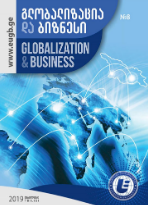TIME SERIES MODELS FOR FORECASTING EXCHANGE RATES
DOI:
https://doi.org/10.35945/gb.2019.08.020საკვანძო სიტყვები:
EXCHANGE RATE, FORECASTING EXCHANGE RARE, TIME SERIES ANALYSIS, ARIMA, MOVING AVERAGE MODEL, SIMPLE AND DOUBLE EXPONENTIAL SMOOTHING MODELSანოტაცია
This paper investigates the behavior of daily exchange rate of the Georgian Currency LARI (GEL) exchange rate against the USDand EUR. To forecast exchange rates there are numerous models, which tend from very simple to very complicated models for analysis of GEL/USD and GEL/EUR time series variable. The objective of this paper is to compare the performance of individual time series models for predicting exchange rates. We will investigate the application of following time series analysis models: moving average, ex- ponential smoothing, double exponential smoothing adjust- ed for trend, time-series decomposition models, and ARIMA class models. The forecasting ability of these models is subsequently assessed using the symmetric loss functions which are the Mean Absolute Percentage Error (MAPE), the Mean Absolute deviation (MAD), and the Mean Squared error /de- deviation (MSE/MSD). In some cases, predicting the direction of exchange rate change may be valuable and profitable. Hence, it is reasonable to look at the frequency of the correctpredicted direction of change by used models, for short - FCPCD.
An exchange rate represents the price of one currency in terms of another. It reflects the ratio at which one currency can be exchanged with another currency. Exchange rates forecasting is a very important and challenging subject of finance market, to determine optimal government policies as well as to make business decisions. This is important for all that firms which having their business spread over different countries or for that which raise funds in different currency. Business people mainly use exchange rates forecasting results in following types of decisions like choice currency for invoicing, pricing transactions, borrowing and landing currency choice, and management of open currency positions. The forex market is made up of banks, commercial companies, central banks, investment management firms, hedge funds, and retail forex brokers and investors. Forecasting the short- run fluctuations and direction of change of the currency ex- change rates is important for all these participates.
The main goal of this study is to forecast of future ex- change rate trends by using currency rates time-series, rep- resenting past trends, patterns and waves. The monetary policy of the National Bank of Georgia since 2009 have been followed the inflation targeting regime, where exchange rate regime is floating - change of exchange rate is free. The offi- cial exchange rate of the Georgian GEL against the USD is cal- culated each business day. The official exchange rate of GEL against USD is calculated as the average weighted exchange rate of the registered spot trades on the interbank market functioning within the Bloomberg trade platform. Then, the official exchange rate of GEL against other foreign currencies is determined according to the rate on international markets on the basis of cross-currency exchange rates.
All simple moving averages are lagging indicators and have tendency to be “behind” the price.Exponential mov- ing average reduces the lag in the SME. Predicted exchange rates do not tend to be lower or higher for some period than the real exchange rate. Although, despite this advantage and much better in accuracy measures, it falls far behind in recog- nizing change direction – FCPCD. As concerns ARIMA Models: All three selected models (ARIMA (2, 1, 2) for GEL / USD and ARIMA (1, 1, 2) - GEL / EUR have minimum AIC and BIC, and also have the minimum MSD. One order (d = 1) difference turned out sufficient to transform the initial non-stationary time series into stationary.
Downloads
ჩამოტვირთვები
გამოქვეყნებული
გამოცემა
სექცია
ლიცენზია
საავტორო უფლებები (c) 2019 Globalization and Business

ეს ნამუშევარი ლიცენზირებულია Creative Commons Attribution-NonCommercial-ShareAlike 4.0 საერთაშორისო ლიცენზიით .









